Author
by Eric Meier ©
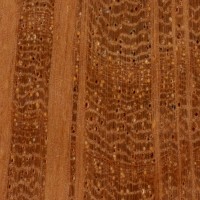
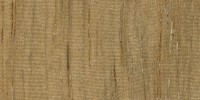
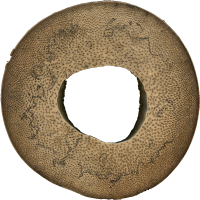 For further information log on website :
For further information log on website :
http://www.wood-database.com/wood-articles/hardwood-anatomy/
by Eric Meier ©
In sharp contrast to the simple anatomy of softwoods, the hardwoods of the world exhibit a dazzling array of endgrain patterns and intricate motifs; and it’s in this complexity that the challenge (and joy) of wood identification really comes alive. An unknown hardwood sample could be just about anything under the sun, yet as each anatomical feature is considered, anything is narrowed down to something.
That is to say, throughout the identification process, the more observations that can be made and classified about a hardwood sample, the more and more the field of possible candidates narrows. Ultimately, the point is reached where no further refinements can be recorded, and either a clear identification emerges, or a handful of possibilities remain.
As discussed on the page The Truth Behind Wood Identification, a positive identification down to the species level isn’t always possible, but generally, anything can be narrowed down to a more descriptive something, and in many cases, the genus or family of the wood can usually be ascertained. To begin this process, the largest and most conspicuous anatomical elements are examined first.
Vessel Elements
When viewed from the endgrain, vessels simply appear to be holes in the wood—what are commonly referred to as pores.
In a live tree, vessels serve as the pipelines within the trunk, transporting sap within the tree. (Softwoods completely lack vessels, and instead rely on tracheids for sap conduction.) Vessel elements are the largest type of cells, and unlike the other hardwood cell types, they can be viewed individually—oftentimes even without any sort of magnification.
For simplicity’s sake, vessel elements will simply be referred to as pores throughout this website.
Hardwoods are initially divided into three main categories according to the arrangement of their pores, commonly called its porosity.
In temperate zones, it’s not unusual for hardwood pores to correspond to the annual growing season, with larger pores forming a band or ring along the earlywood zone. This category of porosity is called ring-porous.
The second category—common in many tropical species—occurs when the pores are distributed evenly throughout the wood. (Growth rings may still be discernible through other cell types, such as parenchyma bands, or a change of color in the wood fibers, but the largest elements—the pores—will be spread out and diffused throughout the wood.) This category of porosity is called diffuse-porous.
Additionally, a third, intermediate arrangement is also seen, which is sometimes difficult to define. It includes wood that has pores that are generally evenly spaced but grade from large to small between growth rings, subtly suggesting growth boundaries. (Wood species with pores of a uniform size that are arranged in weak or broken bands are considered by some sources to be a part of this intermediate category as well.) This intermediate category of porosity is interchangeably called either semi-ring-porous or semi-diffuse-porous; for simplicity’s sake, this group will be referred to as semi-ring-porous throughout this website.
In addition to the foundational three-fold categorization of the pores, there’s also a few other factors pertaining to pores to consider in hardwood identification.
Pores generally occur as single, solitary openings, called solitary pores. When 90% or more of the pores in a wood sample are solitary, it is said to be exclusively solitary, (many species of Eucalyptus are a good example of this). However, despite the commonness of solitary pores, most woods do not have exclusively solitary pores.
Pores also occur in multiples; this appears as two (or more) adjacent pores where the middle wall between them is clearly shared, and is thus considered a pore multiple. When viewed from the endgrain, pore multiples are typically arranged vertically (radially), and are more specifically termed radial multiples. By far the most common pore distribution is a moderate mixture of solitary pores and radial multiples of two to three pores.
In addition to regular radial multiples, other less common pore multiple formations can also occur. For instance, when pores are bordered by other adjacent pores on both the vertical (radial) and horizontal (tangential) sides, they’re called pore clusters.
When radial multiples are four or more pores long, they’re sometimes referred to as pore chains.
Besides the actual pore grouping, pores can also occur in other noteworthy patterns. For instance, Jarrah (Eucalyptus marginata) features pores that are exclusively solitary, but they are arranged in diagonal rows forming zigzag patterns. This classification includes pores that are in a more-or-less vertical (radial) orientation.
Another arrangement that is sometimes seen is when the pores occur in straight or wavy tangential bands. This classification includes pores that are in a more-or-less horizontal (tangential) orientation. This pattern is characteristic of all species of Elm (Ulmus spp.), and is sometimes referred to as ulmiform.
It should be noted that with some of these pore arrangements, (particularly tangential bands), they are generally only found in ring-porous woods, and only observed in the latewood portion of the wood. Depending on the growth rate of the tree, the latewood zones can be wider or narrower than usual. This has the effect of either exaggerating or concealing these patterns, so the growth rate of the tree should be taken into consideration as well.
Pore size
Technically, wood pore diameters are measured in micrometers (sometimes called microns), but the scope and scale of such minute scientific measurements can be hard to grasp. Without a means to actually measure the pore diameters (such as with a microscope outfitted with a micrometer eyepiece), knowing the actual measurements isn’t terribly useful.
Instead, it’s more helpful to simply gauge the pore sizes in comparative terms, (i.e., the pores are relatively small, or they are relatively large). This website will simply use the relative terms such as small, medium or large when describing pore sizes.
| Size | Micrometers (µm) |
| Small | < 50 |
| Medium | 50-100 |
| Large | 100-200 |
| Very Large | > 200 |
In ring-porous woods, pore size should indicate both the size of the earlywood pores (usually medium to very large) as well as the size of the latewood pores (usually very small to medium).
Pore frequency
Pore frequency is generally only measured on diffuse-porous woods; if noted, it’s indicated in comparative terms, such as few, or numerous, rather than by precise microscopic terms such as quantity per square millimeter.
| Frequency | Vessels/mm2 |
| Very Few | < 5 |
| Few | 5-20 |
| Moderately Numerous | 20-40 |
| Numerous | 40-100 |
| Very Numerous | > 100 |
In some instances, considering the pore frequency can prove to be an important distinguishing factor in identification. In the case of distinguishing Brazilian Rosewood (Dalbergia nigra) from East Indian Rosewood (Dalbergia latifolia), one species (D. nigra) has much more infrequent pores, which proves to be a reasonably good discriminator.
The wood sample on the left is Brazilian Rosewood (Dalbergia nigra), which has very few pores. The sample on the right is East Indian Rosewood (Dalbergia latifolia), a close relative which is frequently confused with Brazilian Rosewood; its pores are about twice as numerous as the Brazilian sample.
Pore contents
Besides simply considering the size or arrangement of the pores, sometimes it pays to observe what’s actually in them. As sapwood becomes heartwood, certain substances and structures are deposited in the wood cells.
In some cases, pores can become filled with colored gums, resins, or other deposits that can aid in identification. In most species, heartwood deposits tend to be somewhat sporadic, so it shouldn’t be relied upon as a primary identifying feature. The frequency of pore contents, if present, are described using the relative terms, sparse, common, and abundant.
Another common by-product of the conversion of sapwood to heartwood is the appearance of tyloses. Tyloses (singular, tylosis) appear as bubble-like structures that grow into open pores, and in some cases, completely stop-up the pores of the heartwood.
| The sample of Panga Panga (Millettia stuhlmannii) on the left has quite a few heartwood deposits; many are a striking yellow, while some are a dark brown. On the right is a sample of Black Locust (Robinia pseudoacacia), which is a superb example of a wood with pores that are abundantly packed with tyloses. | |
Some species lack tyloses altogether, while many others have an intermediate distribution ranging from sparse to common, while some species have tyloses in abundance, to the point that nearly every heartwood pore is filled with tyloses. This blockage has the beneficial effect of rendering the pores essentially watertight: a well known example of this is found in White Oak (Quercus alba), whose packed pores are commonly used for barrel-making (also known as cooperage).
Parenchyma
In a living tree, the parenchyma contained in the sapwood consists of living tissue that serves as storage cells. Technically, there are a few different types of parenchyma cells seen in wood, (such as those occurring radially in the rays), but far and away the most common type of cells that are designated specifically as parenchyma refer to longitudinal or axial parenchyma, which are oriented along the length of the tree-trunk. All references to parenchyma in this website will be describing axial parenchyma.
Single parenchyma cells are typically too small to be seen individually, but when viewed as a whole, patterns and shapes emerge. Very infrequently, parenchyma is absent or hardly observable, but in most hardwood species, parenchyma forms unique and telling patterns that greatly aid in the identification process. In describing parenchyma, there are two main classifications.
Apotracheal parenchyma
In order to understand this somewhat intimidating scientific term, it may help to consider the English word “trachea,” which refers to a tube or pipe (in this case, a wood pore). Combine this with the Greek prefix “apo,” which means away from or separate, and the meaning becomes clearer.
Apotracheal refers to parenchyma cells that occur separate from the pores. Apotracheal parenchyma can occur as single scattered cells, classified as diffuse parenchyma. These cells are too small to be seen without a microscope. However, in some wood species, several apotracheal parenchyma cells are joined or aggregated together, forming thin but visible tangential lines. This formation is known as diffuse-in-aggregates parenchyma.
Honduran Rosewood (Dalbergia stevensonii) displays a multitude of diffuse-in-aggregates parenchyma, typical of many Dalbergia-genus rosewoods. Any apotracheal parenchyma in contact with neighboring pores is incidental.
Paratracheal parenchyma
The counterpart to apotracheal parenchyma is paratracheal parenchyma. The Greek prefix “para” means beside or near, and the classification of paratracheal describes parenchyma that occurs in association with the wood’s pores. Of the two classifications, paratracheal parenchyma exhibits a much wider range of patterns and variations.
Paratracheal parenchyma can occur as single cells bordering a pore, called scanty parenchyma. These cells are too small to be seen individually without a microscope, and along with diffuse parenchyma, will not be given further consideration in this website.
The most basic paratracheal parenchyma formation is a ring or circle of cells surrounding the pore, which is termed vasicentric parenchyma. The term vasicentric is simply a combination of the words vase (suggesting a vessel or pore), and centric, which simply indicates that the parenchyma is centered around the pore. It should be noted that vasicentric parenchyma isn’t always visible with a hand lens. If the pores of a wood species are especially small, (with the parenchyma being even smaller), or if the parenchyma ring is only one cell thick, it may not be clearly visible with a hand lens.
Another form of parenchyma that is closely related to vasicentric is aliform parenchyma. This term literally means “wing-shaped.” Despite the suggestive name, there are actually two primary variants of aliform parenchyma: the first is winged, where short appendages or wings of parenchyma extend from one or both sides of the pore.
The second variant of aliform is lozenge, where the parenchyma surrounding the pore takes on a diamond or elongated oval shape.
Building on the vasicentric and aliform parenchyma patterns, another formation is confluent parenchyma. This occurs when the parenchyma is so extensive that it extends outward and makes contact with the parenchyma from neighboring pores.
One last, somewhat uncommon form of paratracheal parenchyma is sometimes seen in a handful of wood species. Whether the parenchyma occurs in a vasicentric, aliform, or a confluent pattern, when the parenchyma covers only one side of the pore in a semicircular fashion, it is said to be unilateral parenchyma.
When horizontal (tangential) bands of parenchyma occur either as (apotracheal) diffuse-in-aggregates, and/or as extensions of aliform or confluent (paratracheal) parenchyma, it is known as banded parenchyma. Banded parenchyma can be in continuous bands, or it can occur in interrupted or discontinuous bands. The bands can be very thick—constituting over half of the wood’s overall volume in some species—or they can be very thin and hardly visible with a hand lens. The bands can be very numerous and evenly spaced, or they can be very sparse and sporadic.
In some species, banded parenchyma can also occur along the growth ring boundary, and is termed marginal parenchyma. Such parenchyma bands can act as growth-ring indicators in some diffuse-porous woods where the annual growth boundaries would be otherwise indistinguishable.
Other variations of banded parenchyma involve the relationship between the parenchyma (horizontal bands) and the rays (vertical bands). When both the parenchyma and rays occur in thin, closely spaced bands forming a net or grid-like pattern, this is termed reticulate parenchyma.
When the parenchyma occurs in slightly narrower intervals than the rays, appearing as rungs on a ladder, it is termed scalariform parenchyma—so named for its resemblance of scales on a fish or reptile. Wood samples with scalariform parenchyma typically have very wide rays, and short, arched parenchyma bands between the rays.
Rays
Found on practically every wood species, rays can ofttimes serve to provide valuable clues in the identification process. In a living tree, these cells actually run perpendicular to the rest of the wood fibers, and serve to channel nutrients between the cambium, sapwood, and pith. When viewed from the endgrain, rays appear as more-or-less straight, radial (vertical) lines spaced evenly across the wood sample.
Ray width
When viewed under a microscope, ray width can be measured in perfect precision by the number of cells across the ray. Wood species with the thinnest rays measure only one or two cells wide, (called uniseriate, and biseriate, respectively), while some of the widest rays can measure well over a dozen cells wide.
However, when viewed with a hand lens, individual ray cells cannot be counted, and more generic comparative terms, such as narrow, medium, or wide are used to describe the ray width.
| Width | Number of Cells |
| Narrow | 1-3 seriate |
| Medium | 3-5 seriate |
| Wide | 5-10 seriate |
| Very Wide | > 10 seriate |
However, using these generic terms are an imperfect compromise, as the individual rays cells can vary in width, so a narrow uniseriate ray with large cells may visually appear just as wide as a medium-width ray that’s made up of smaller cells.
In addition to noting the average width of the rays, some species also have two distinct sizes of rays present. In the case of Hard Maple (Acer saccharum), its combination of wide and narrow ray widths can help distinguish it from other soft maples.
The sample of Hard Maple (Acer saccharum) on the left has two distinct ray widths—some are relatively narrow, while others are wider. The sample Silver Maple (Acer saccharinum) on the right shows only slight variations in ray width.
Ray spacing
In addition to their width, rays are also measured by their spacing, usually expressed as a quantity per millimeter. However, because of the impracticality of obtaining precise counts per millimeter using only a hand lens, comparative terms will be used.
| Spacing | Rays/mm |
| Wide | < 5 |
| Normal | 6-9 |
| Fairly Close | 10-13 |
| Close | 14-20 |
| Extremely Close | > 21 |
(It should be noted that in cases where the rays are spaced extremely close together, the rays tend to be so small and narrow that they can’t always be discerned with a hand lens.)
The sample of Hackberry (Celtis occidentalis) on the left shows a wide ray spacing, while the Katalox (Swartzia spp.) on the right has rays that are spaced fairly close together.
Aggregate rays
Occasionally, some species will have intermittent rays that are many times wider than the rest. These mega-rays are essentially a collection of a number of normal-sized rays grouped together and appearing as one large ray. They are known as aggregate rays.
Perhaps the most well-known commercial lumber in the United States that features aggregate rays is Red Alder (Alnus rubra). In addition to Alder, only a handful of other genera and species exhibit these rays: Hornbeam (Carpinus spp.), and some species of Sheoak (Allocasuarina and Casuarina spp.) and Oak (Quercus spp.) also feature aggregate rays.

The enormous rays seen scattered throughout this sample of Sheoak (Allocasuarina spp.) are a perfect example of the exaggerated nature of aggregate rays.
Occurrence of the large rays is very sporadic—some samples may not contain any aggregate rays at all, while other pieces will have several. The aggregate rays of Alder are so large and conspicuous that they can be observed on flatsawn surfaces as thin dark streaks, and may be mistaken for defects in the wood.
Noded rays
In some species, the rays will slightly flare out and get wider as they cross a growth ring boundary. This subtle characteristic is referred to as noded rays.
While noded rays are fairly uncommon, they can occasionally serve to help in identifying certain woods. Noded rays are present in Sycamore (Platanus spp.), Beech (Fagus spp.), Basswood (Tilia spp.), and Yellow Poplar (Liriodendron tulipifera).
Storied rays
One final characteristic of rays involves examining the flatsawn (tangential) surface of the wood. In some wood species, (particularly those in tropical regions), the rays tend to be aligned in horizontal or diagonal tiers, also referred to as stories. This pattern is called storied rays, and it produces a visual phenomenon known as ripple marks.Even though there’s technically no unevenness in the wood, to the unaided eye, (and at low levels of magnification), storied rays appear as minute stripes of wood alternating between light and dark. In addition to the rays, other anatomical features (such as the parenchyma or the fibers) can also form stories, and therefore produce ripple marks.

This flatsawn view of Persimmon (Diospyros virginiana) exhibits ripple marks. Besides the rays, Persimmon also has numerous other storied structures present. (4×)
In addition to Persimmon (Diospyros virginiana)—a temperate species—some notable tropical species with storied structures include: most rosewoods (Dalbergia spp.), Honduran Mahogany (Swietenia macrophylla), and Sapele (Entandrophragma cylindricum).
Wood Fibers
In a living tree, hardwood fibers have strong, thick cell walls that mainly serve to support and strengthen the trunk. When viewed from the endgrain, fibers are very small and can’t be seen individually. Instead, fibers can only be distinguished in a broader sense as colored areas which form the backdrop of the wood’s endgrain.
Occasionally, the wood fibers will change in color in correlation with the growing season, providing a means to distinguish the growth ring boundaries in instances where it may not be apparent in the arrangement of pores or marginal parenchyma.
Monocots: A Special Case
Hardwoods are classified as dicotyledons, (or “dicots” for short) because they have two cotyledons (embryonic leaves). That is to say, when a dicot first emerges from its seed, the seedling will have two leaves. Most of the world’s fruits, vegetables, and fibers are dicots.
However, within the division of Angiosperms (flowering plants) there are also plants that only have one embryonic leaf, called monocotyledons, or “monocots” for short. This important group contains corn, wheat, rice, and all true grasses. In the woodworking world, the most notable monocots are palm and bamboo.
Anatomically, the “wood” of monocots is diverse from both hardwoods and softwoods, and can usually be spotted easily, even without magnification. Viewing the endgrain reveals a fairly simple structure of darker-colored fibrovascular bundles embedded throughout a mass of lighter-colored parenchyma cells. Growth rings, sapwood/heartwood, and rays are all completely absent.
Narrowing most monocots down to even the genus level (let alone to a precise species) is essentially impossible—at least when limited to the anatomical features of the wood itself. There just aren’t enough distinguishing features present to discern between different species. Fortunately, in woodworking and lumber applications, there are generally only a few types of monocots encountered.
Palm
These tropical monocots have no growth rings, and when viewed on end, a palm log will appear as a circular gradient between the darker (and stronger) fibrovascular bundles along the outer edge, and the lighter (and softer) parenchyma structure in the center. Toward the outer wall of the trunk, the density of the wood is the greatest, and gradually becomes lighter, softer, and weaker towards the soft core.
Palm lumber is typically divided into two general categories: red, and black. Red Palm is commonly harvested from the Coconut Palm (Cocos nucifera), but other genera and species are also used. As the name implies, the fibrovascular bundles have a reddish hue. Black Palm is harvested from at least five different genera, and is identified by its darker, nearly black fibrovascular bundles, which contrast with the pale grayish brown parenchyma.
On the upper left is a sample of Red Palm (Cocos nucifera), with the endgrain pictured directly below it. The right sample is Black Palm (Borassus spp.)—the color contrast between the darker fibrovascular bundles and the parenchyma creates a streaked look that is unique to palms. In both endgrain samples, the fibrovascular bundles can clearly be seen without any sort of magnification—a hallmark of monocots.
Bamboo
These fast growing members of the grass family (Poaceae) are very diverse, with hundreds of species encompassing dozens of genera. Unlike trees, bamboo initially grows at full width, with no tapering or horizontal growth.
Much like palm, bamboo has fibrovascular bundles that are more concentrated near the edge of the stem—also called the culm—with softer parenchyma grading in toward the inner wall. Bamboo culms are hollow in the center, with closed “nodes” generally occurring every few feet or so.
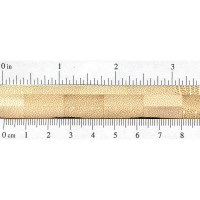
Bamboo (endgrain)
|
The sample above is Bamboo (possibly Phyllostachys spp.), which shows subtle interruptions in the grain pattern at the nodes (seen in the right-hand third of the face grain portion). The endgrain also shows smaller strips that have been laminated to form a larger plank.

Giant Bamboo (endgrain)
Note the increasing concentration of fibrovascular bundles near the edge of the endgrain section of Giant Bamboo (Dendrocalamus asper).
Because bamboo has such a small (and hollow) diameter, various techniques are used to manufacture what could be loosely termed as “boards.” Uniformly small strips of bamboo and machined and then glued together to form larger planks, slabs, and plywood for a number of applications, including, flooring, construction, and furniture.
http://www.wood-database.com/wood-articles/hardwood-anatomy/
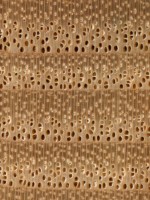
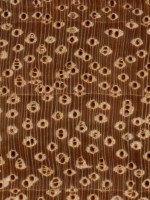
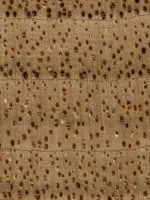
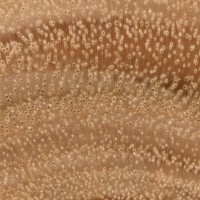
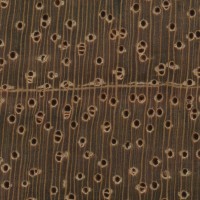
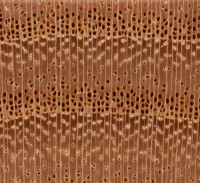
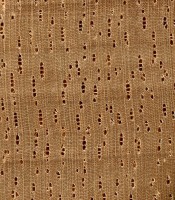
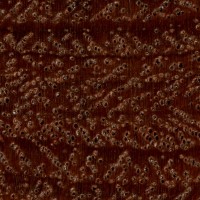
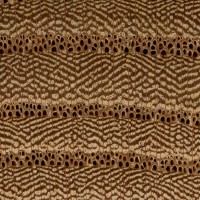
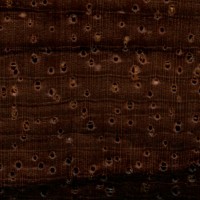
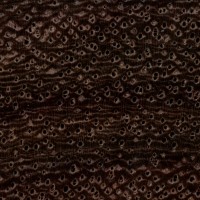
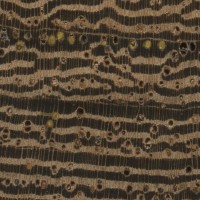
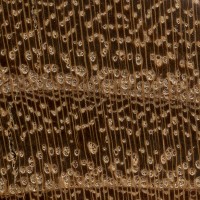
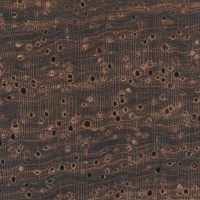
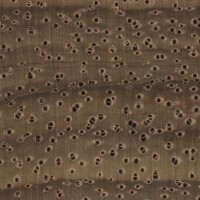
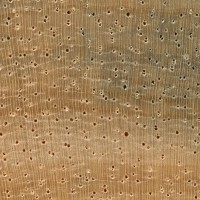
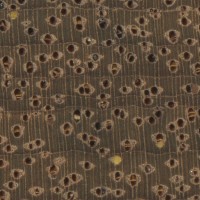
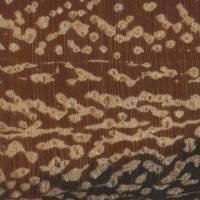
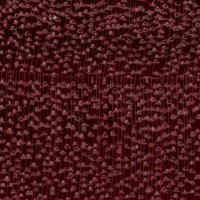
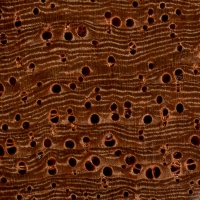
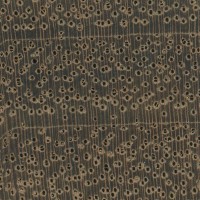
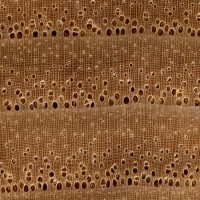
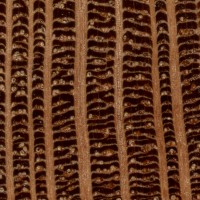
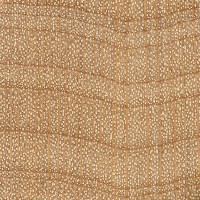
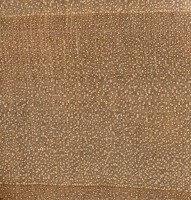
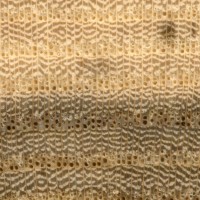
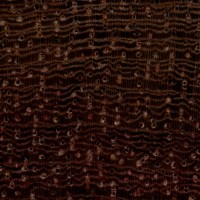
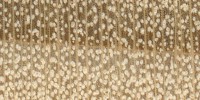
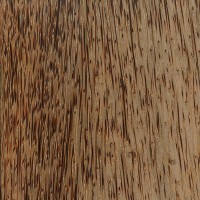
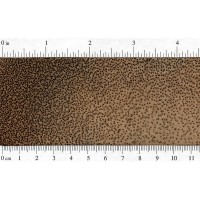
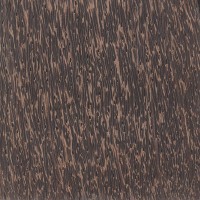
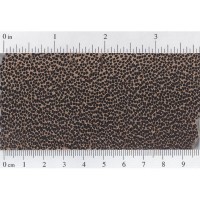
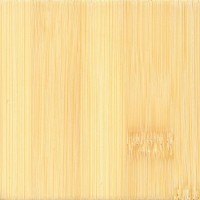





No comments:
Post a Comment